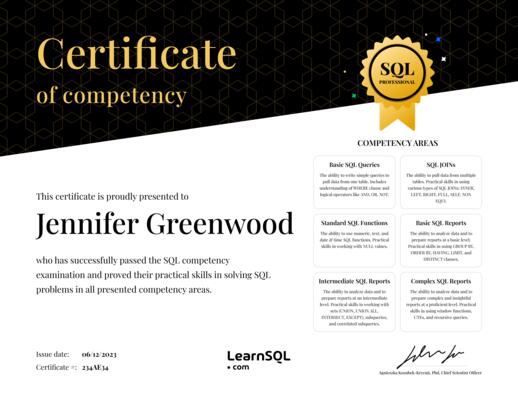Advanced Track
Creating Database Structure
Learn how to create and manage tables, views, and indexes in popular relational database management systems like MySQL, SQL Server, Oracle, and PostgreSQL.
4.89
6,334 Lerners enrolled
Free trial Yes
Certificate of completion Yes
Estimated time 50 h
Courses included 5
Skills you will gain
- Create and manage tables
- Identify and use common SQL data types in your projects
- Define primary and foreign keys
- Implement constraints for data integrity
- Create, modify, and manage SQL views
- Optimize query performance with indexes
Last reviews

Track courses
-
The Basics of Creating Tables in SQL80 Coding challenges Basic
Discover the basic building blocks of creating tables in MySQL, SQL Server, Oracle, and PostgreSQL. Learn all about primary keys, foreign keys, and the CREATE TABLE command.
-
Data Types in SQL89 Coding challenges Basic
Choose the right type of data for your needs. A data type tells the database what kind of information a column will store. Learn about common data types in SQL Server, MySQL, Oracle, and PostgreSQL.
-
SQL Constraints76 Coding challenges Basic
Constraints tell the database how to check the correctness of input data. Get to know the constraints available in SQL Server, MySQL, Oracle, and PostgreSQL. Learn how to create and alter constraints in a relational database.
-
Working with Views36 Coding challenges Advanced
Query more effectively with SQL views! A view is a saved SQL query. Learn how to create, modify, and remove views in SQL Server, MySQL, Oracle, and PostgreSQL.
-
Understanding Indexes55 Coding challenges Advanced
To be a database professional, you must understand how indexes work. These structures help the database to execute SQL queries faster. Learn how to create indexes and how to write SQL queries that best utilize them.

Get the Certificate of Competency in SQL
This certificate will confirm your practical SQL problem-solving skills

Description
Discover the secrets of creating and managing the structure of a relational database. Do you work with relational databases? Want to learn how to create tables, views, and indexes? This track is especially for you. It will help you understand the technical side of data storage and learn how to manage it more efficiently.
In this track, you will learn SQL’s Data Definition Language (DDL) - the syntax used to create, modify, and remove tables, views, and indexes. To get the most out of it, you should know the basics of SQL, especially the DML (data manipulation language) part. We assume that you know when to use SELECT, INSERT, UPDATE, and DELETE.
(If you’re not familiar with the above SQL commands, start with our How to INSERT, UPDATE, and DELETE data in SQL course and then come back to this one.)
Creating Database Structure consists of five interactive courses. The first two deal with creating tables: you’ll learn the basic syntax of CREATE TABLE, uncover different data types, and learn how to select the right data types for your needs. The third course delves into constraints, or how databases verify the correctness of data. The last two courses will teach you how to work with views and indexes.
After completing this track, you'll know how to create, modify, and remove database objects.
All courses in the track are based on standard SQL. That means that you will be able to use the skills acquired here in almost any relational database management system (RDMS), including Oracle, SQL Server, MySQL, and PostgreSQL. We believe people learn best through practice and interactive tasks. So, during this course, you’ll write real SQL commands directly in the browser. Our platform runs and verifies your solution, letting you see how things work in real time. You don't have to install or set up anything on your device.